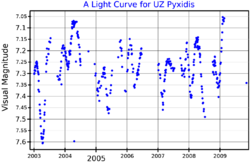Astronomy:UZ Pyxidis
| Observation data Equinox J2000.0]] (ICRS) | |
|---|---|
| Constellation | Pyxis |
| Right ascension | 08h 46m 36.3323s[2] |
| Declination | −29° 43′ 41.203″[2] |
| Apparent magnitude (V) | 6.99 - 7.63[3] |
| Characteristics | |
| Spectral type | C55J (R8)[3] |
| U−B color index | +2.99[4] |
| B−V color index | +2.01[4] |
| Variable type | SRb[5] |
| Astrometry | |
| Radial velocity (Rv) | 13.00[6] km/s |
| Proper motion (μ) | RA: −5.767[2] mas/yr Dec.: 1.674[2] mas/yr |
| Parallax (π) | 0.8949 ± 0.0183[2] mas |
| Distance | 3,640 ± 70 ly (1,120 ± 20 pc) |
| Absolute magnitude (MV) | −1.2[7] |
| Details | |
| Mass | 2.1[8] M☉ |
| Radius | 221[9] R☉ |
| Luminosity | 5,649[10] L☉ |
| Surface gravity (log g) | −0.236[8] cgs |
| Temperature | 3,325[10] K |
| Metallicity [Fe/H] | −0.32[8] dex |
| Other designations | |
| Database references | |
| SIMBAD | data |
UZ Pyxidis (HD 75021) is a semiregular variable star in the constellation Pyxis. It is located about 3,600 light-years (1,100 parsecs) away from the Earth.
UZ Pyxidis lies directly between α and γ Pyxidis. It has a common proper motion companion, HD 75022,[11] less than 2' away but the two are not listed in double star catalogues.
UZ Pyxidis is a carbon star. These types of stars are known for having large amounts of carbon in their atmospheres, forming carbon compounds that make the star appear strikingly red. It was first recognised as having an unusual spectrum in 1893.[12] Under the Morgan–Keenan classification of carbon stars, UZ Pyxidis' spectral type is C55; if it were a normal giant star, this would correspond to a spectral type of about K5.[13] It is also unusual in that it has very strong isotopic bands of C2 and CN.[14]
UZ Pyxidis is classified as a semiregular variable with a dominant period of 159.6 days. It varies in brightness between magnitude 6.99 and 7.63.[3] The variability was first reported in 1972,[15][11] and the variable star designation UZ Pyxidis was assigned in 1978.[16]
References
- ↑ "ASAS All Star Catalogue". The All Sky Automated Survey. http://www.astrouw.edu.pl/asas/?page=aasc.
- ↑ 2.0 2.1 2.2 2.3 2.4 Brown, A. G. A. (2021). "Gaia Early Data Release 3: Summary of the contents and survey properties". Astronomy & Astrophysics 649: A1. doi:10.1051/0004-6361/202039657. Bibcode: 2021A&A...649A...1G. Gaia EDR3 record for this source at VizieR.
- ↑ 3.0 3.1 3.2 Otero, Sebastian Alberto (15 April 2012). "VSX: Detail for UZ Pyx". The International Variable Star Index. American Association of Variable Star Observers. https://www.aavso.org/vsx/index.php?view=detail.top&oid=27220.
- ↑ 4.0 4.1 Platais, I.; Pourbaix, D.; Jorissen, A.; Makarov, V. V.; Berdnikov, L. N.; Samus, N. N.; Lloyd Evans, T.; Lebzelter, T. et al. (2003). "Hipparcos red stars in the HpVT2 and VIC systems". Astronomy and Astrophysics 397 (3): 997–1010. doi:10.1051/0004-6361:20021589. Bibcode: 2003A&A...397..997P.
- ↑ Samus, N. N. et al. (2009). "VizieR Online Data Catalog: General Catalogue of Variable Stars (Samus+ 2007-2013)". VizieR On-line Data Catalog: B/GCVS. Originally Published in: 2009yCat....102025S 1. Bibcode: 2009yCat....102025S.
- ↑ Gontcharov, G. A. (2006). "Pulkovo Compilation of Radial Velocities for 35 495 Hipparcos stars in a common system". Astronomy Letters 32 (11): 759–771. doi:10.1134/S1063773706110065. Bibcode: 2006AstL...32..759G.
- ↑ Gontcharov, G. A. (2011). "The red giant branch in the Tycho-2 catalogue". Astronomy Letters 37 (10): 707–717. doi:10.1134/S1063773711090040. Bibcode: 2011AstL...37..707G.
- ↑ 8.0 8.1 8.2 Anders, F.; Khalatyan, A.; Queiroz, A. B. A.; Chiappini, C.; Ardevol, J.; Casamiquela, L.; Figueras, F.; Jimenez-Arranz, O. et al. (2022). "VizieR Online Data Catalog: StarHorse2, Gaia EDR3 photo-astrometric distances (Anders+, 2022)". Vizier Online Data Catalog. Bibcode: 2022yCat.1354....0A.
- ↑ Stassun, Keivan G. et al. (2019-10-01). "The Revised TESS Input Catalog and Candidate Target List". The Astronomical Journal 158 (4): 138. doi:10.3847/1538-3881/ab3467. ISSN 0004-6256. Bibcode: 2019AJ....158..138S.
- ↑ 10.0 10.1 Bergeat, J.; Chevallier, L. (2005). "The mass loss of C-rich giants". Astronomy and Astrophysics 429: 235–246. doi:10.1051/0004-6361:20041280. Bibcode: 2005A&A...429..235B.
- ↑ 11.0 11.1 Eggen, O. J. (1972). "The classification of intrinsic variable stars. I. The red variables of type N". Astrophysical Journal 174: 45. doi:10.1086/151467. Bibcode: 1972ApJ...174...45E.
- ↑ Fleming, W. P. (1893). "Stars having peculiar spectra". Astronomy and Astro-Physics 12: 546. Bibcode: 1893AstAp..12..546F.
- ↑ Keenan, P. C.; Morgan, W. W. (1941). "The Classification of the Red Carbon Stars". The Astrophysical Journal 94: 501. doi:10.1086/144356. Bibcode: 1941ApJ....94..501K.
- ↑ Keenan, P. C. (1993). "Revised MK Spectral Classification of the Red Carbon Stars". Publications of the Astronomical Society of the Pacific 105: 905. doi:10.1086/133252. Bibcode: 1993PASP..105..905K.
- ↑ Eggen, O. J. (1972). "The classification of intrinsic variable stars. II. The red variables of S and related types". Astrophysical Journal 177: 489. doi:10.1086/151725. Bibcode: 1972ApJ...177..489E.
- ↑ Kholopov, P. N.; Kukarkina, N. P.; Perova, N. B. (1978). "63rd Name-List of Variable Stars". Information Bulletin on Variable Stars 1414: 1. Bibcode: 1978IBVS.1414....1K.
 |


